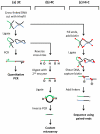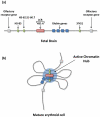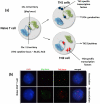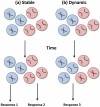Interchromosomal association and gene regulation in trans
- PMID: 20236724
- PMCID: PMC2865229
- DOI: 10.1016/j.tig.2010.01.007
Interchromosomal association and gene regulation in trans
Abstract
The nucleus is an ordered three-dimensional entity, and organization of the genome within the nuclear space might have implications for orchestrating gene expression. Recent technological developments have revealed that chromatin is folded into loops bringing distal regulatory elements into intimate contact with the genes that they regulate. Such intrachromosomal contacts appear to be a general mechanism of enhancer-promoter communication in cis. Tantalizing evidence is emerging that regulatory elements might have the capacity to act in trans to regulate genes on other chromosomes. However, unequivocal data required to prove that interchromosomal gene regulation truly represents another level of control within the nucleus is lacking, and this concept remains highly contentious. Such controversy emphasizes that our current understanding of the mechanisms that govern gene expression are far from complete.
Copyright 2010 Elsevier Ltd. All rights reserved.
Figures





References
-
- Cremer T, et al. Rabl’s model of the interphase chromosome arrangement tested in Chinese hamster cells by premature chromosome condensation and laser-UV-microbeam experiments. Hum Genet. 1982;60:46–56. - PubMed
-
- Tanabe H, et al. Inter- and intra-specific gene-density-correlated radial chromosome territory arrangements are conserved in Old World monkeys. Cytogenet Genome Res. 2005;108:255–261. - PubMed
-
- Mora L, et al. Chromosome territory positioning of conserved homologous chromosomes in different primate species. Chromosoma. 2006;115:367–375. - PubMed
Publication types
MeSH terms
Substances
Grants and funding
LinkOut - more resources
Full Text Sources

